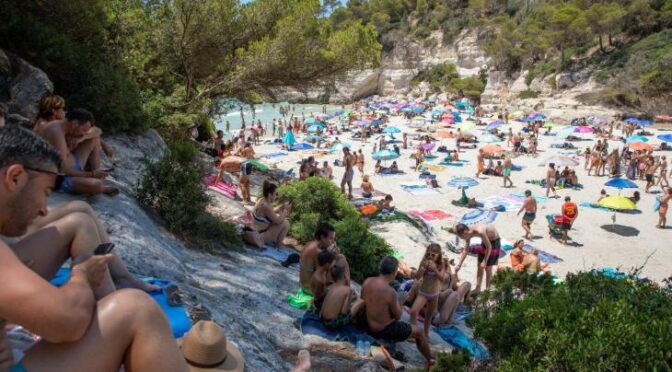Views: 1159
An excessive number of vehicles, overcrowded spaces, water shortages, and increased energy pollution are all consequences of Menorca’s growing touristification. When combined with housing difficulties and a gradual drop in per capita income, it is clear that the island’s tourism model needs rethinking.
On World Tourism Day, the GOB reflects on the growing social unrest in many nearby tourist hotspots.
Institutional advertising about World Tourism Day often showcases a preserved Menorca — without hotels, without villas, without vehicles, without overcrowding. These images are promoted because officials know this is what gives Menorca its unique value. However, the reality of the tourism season is increasingly distant from these idealized pictures.
The congestion on the island’s virgin beaches is not being addressed. This year, Cala Mitjana’s parking lot was expanded, further worsening an already critical situation. Allowing iconic beaches to operate under triple the maximum pressure they can handle is a deception to visitors.
A technical study, which the Insular Council dislikes, shows that Menorca hosts 30% more vehicles than it can manage during the summer. The vehicle surplus leads to increased insecurity and a decline in quality. If Formentera successfully established limits to cars, Menorca should be able to do the same, especially as a Biosphere Reserve. Failing to take action means exacerbating the problem.
Overcrowding and chaos also affect the island’s marine areas, where excessive boat speeds endanger swimmers — the largest unprotected group. Studies of carrying capacity show that the maximum threshold has already been exceeded. Therefore, it makes no sense to promote dry marinas or ways to allow even more boats on the sea.
There are no concrete water-saving policies in place, while new desalination plants are being announced. This approach overlooks the failure of Ciutadella’s desalination plant and ignores the exorbitant costs of such facilities, which are paid for by everyone while benefiting only a few private businesses that exploit the water.
The large summer influx of people has rendered the island’s renewable energy efforts insufficient. For the second consecutive year, old power plant engines had to be reconnected to meet the high demand caused by tourist congestion. The so-called “administrative simplification” decree has removed the binding nature of the decarbonization targets set out in the Biosphere Reserve Law.
Tourist rentals have exploded, contributing to the island’s overcrowding, with a significant amount of illegal offers. Inspection results have so far been poor, and a much larger number of fines and sanctions is needed. Menorca also needs to rethink senseless growth projects, like hundreds of new villas planned in Cap d’en Font, the 500 additional tourist spots in Repòs del Rei, or the massive expansion of Coves Noves.
Meanwhile, the island’s per capita income continues to decline. The number of tourists increases, but the benefits for residents keep falling. A review of the tourism model is crucial.
The island is starting to show signs of strain, and public protests must not be ignored. There are ways to move away from the unhealthy path of limitless growth and bring the real Menorca closer to the one shown in tourist ads. It is time to rethink tourism, shed fear, and move from theory to practice. Many citizens are eager to find a better way forward.

